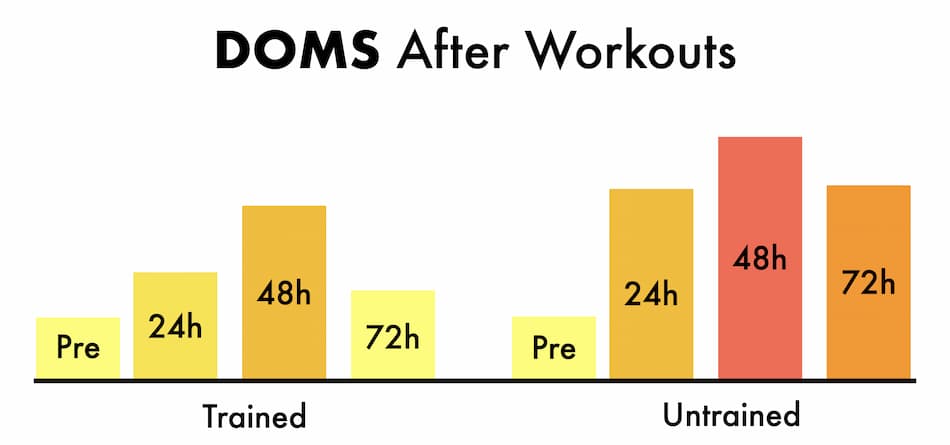Taking a leap and starting a fitness journey when you’re overweight or obese is one of the best decisions you can make. However, some types of workouts may not be suitable for people who are out of shape. Today I will explain if Orangetheory is good for overweight and obese beginners, and what are the alternatives.
In general, Orangetheory fitness is an effective weight loss workout, but it’s not suitable for overweight or obese people. OTF involves doing bootcamp-style interval training with minimum rest in a group setting, and it does not offer close guidance and workout modifications for untrained individuals with limited abilities.

Here is my overall answer, but if you wanna know more about what are the good alternatives, as well as what current research says about HIIT workouts for overweight and obese individuals, keep reading.
Is Orangetheory Good For Overweight Beginners?
One of the reasons why Orangetheory is not good for overweight beginners and obese people is because it doesn’t offer one-on-one support and guidance. All of the OTF workouts are done in a group where people do the same exercises as everyone else.
This is great for people who are already physically fit and want to challenge their bodies. They know how to do exercises safely in a correct way, and are conditioned enough to maintain good form even during high intensity.
On the other hand, most people who are obese and out of shape usually don’t have previous workout experience, which means they are unable to perform the exercise with a good technique.
Some of these movement errors can be fixed on the spot (e.g. keeping abs engaged) but others require specific mobilization and flexibility exercises.
For example, doing kettlebell swings or rowing with a rounded back can indicate a lack of range of motion in the shoulders and a tight thoracic spine.
You can fix that by hiring a trainer who will literally take you by hand, explain, demonstrate and teach all the movement patterns that need to be done in a logical sequence.
The trainer prescribes exercises based on your current fitness level and physical ability. And once you get better, the trainer can introduce more advanced moves to continue making progress.
Unfortunately, Orangetheory coaches cannot give their all attention to only one individual because they have a whole group of people to look after.
Orangetheory workouts are too intense for overweight beginners
Another reason why Orangetheory fitness is not ideal for overweight beginners is that the workouts are too intense. Although exercise is meant to be challenging even for newbies, most of the OTF classes require training at an intensity above 80% of the maximum heart rate for 45-60 minutes.
Of course, the benefits of doing HIIT workouts for overweight and obese people are well documented.
Andrea D’Amuri, Ph.D., a researcher from Italy, said that people with obesity noticed superior effects from doing high-intensity interval training, compared to medium-intensity interval training in regards to changes in body composition and VO2peak.
In healthy adults with obesity, HIIT compared with MICT induced similar weight loss and cardiovascular risk factors improvement but resulted in a larger increase in cardiorespiratory fitness over a shorter period.
D’Amuri, Andrea et al. 2021
This means that HIIT is more time efficient, however, both methods are equally effective and, says Dr. D’Amuri, should be considered as part of a strategy for obesity treatment and primary cardiovascular prevention.
However, the devil is in the detail.
This study was done in a controlled laboratory environment where people were walking on the treadmill, not doing bootcamp-style workouts like OTF.
The exercise protocol from this study included:
| FITT | Details |
|---|---|
| Frequency | 3 sessions per week |
| Intensity | 3 min at 100% max heart rate 1.5 min at 50% max heart rate (recovery) |
| Time | 3-7 intervals (total of 9-21 minutes) |
| Type | Walking on the treadmill |
As you can see, the exercise protocol from this study was completely different from the typical Orangetheory class. OTF workouts are more strenuous, include more complex exercises, and last three times longer.
Plus, the franchise encourages members to aim for 12 splat points per class, which is equivalent to spending 12 minutes at the submaximal intensity levels (heart rate zones 4 and 5).
Again, this is good for conditioned people who can handle hard workouts.
However, for overweight beginners who are deconditioned, have a sedentary lifestyle, cannot touch their toes, and have a less-than-optimal diet, training at heart rate zone 4 and 5 is not ideal.
You can learn more about how to create your own diet plan for orange theory fitness in my article here.
Higher intensity means more time to recover
One of the reasons why deconditioned, overweight beginners should stay away from OTF is because HIIT workouts are strenuous on the body are require significantly more time to recover from DOMS (delayed onset muscle soreness).
Delayed onset muscle soreness refers to the feeling of muscle pain and soreness that happens after strenuous exercise.
Ypatios Spanidis, Ph.D., a researcher from Greece, said that untrained people are more susceptible to oxidative damage and metabolite build-up, compared to trained people.
Take a look at the graph below.

- In trained people (graph on your left) you can see that muscle soreness goes down to baseline within 72 hours after strenuous exercise.
- In untrained people (graph on your right) you can see that muscle soreness not only stays elevated beyond 72 hours but is also significantly higher during the first couple of days after training.
This means that untrained, obese people not only can have a hard time keeping up with the pace at OTF but also will need significantly more time to recover from workouts.
What type of workout is better for overweight beginners?
In general, the best type of workout for overweight beginners is doing strength training in conjunction with low-impact steady-state cardio recovery.
Doing compound exercises under the guidance of a savvy personal trainer can not only maximize weight loss results but also reduces the chances of getting injured.
The last thing you want is injury.
Orangethoery is not suitable for obese beginners because doing HIIT workouts can put stress on the joints and increase the odds of getting injured. Although studies didn’t associate HIIT with an increased risk of injury, higher BMI is one of the leading causes of getting injured.
In other words, the heavier your weight, the greater your chances of getting injured, especially during high-intensity interval training type of workouts.
Is Orangetheory Good For Obese Beginners?
Another reason why obese individuals should not do OTF is that they can have poorer proprioception or kinesthetic perception (body’s internal perception of movement) compared to people with normal weight.
Let me explain.
Kinesthetic perception means the ability to detect changes in body position and movements. It is also the ability to feel and correct postural alignment without having to think about it.
Here are some of the examples:
- Kinesthetic perception means being able to differentiate which muscle works during a certain exercise (e.g. feeling pecs during a bench press).
- Kinesthetic perception means being able to contract the specific muscles during an exercise (e.g. squeezing glutes at the lockout of the hip thrust).
Coaching cues like “engage your abs”, “keep the back straight”, or “squeeze shoulder blades” are heard, but cannot be carried out because the person doesn’t know how does the straight back feel like.
Not only that.
Proprioception is not only about performing the exercise with good form but also about being to feel how this exercise impacts the body.
- Proprioception means being able to tell the difference between muscle pain and joint pain during exercise.
- Proprioception means being able to describe how the exercise makes you feel (e.g. on a scale of 1 to 10)
- Proprioception means being able to sense how many more reps you can do with a given load (e.g. how many reps before you reach muscle failure).
Studies have shown that untrained obese people who live a sedentary lifestyle have poorer proprioception, compared to nonobese people.
Can I Do Orangetheory if I’m Fat and Out of Shape?
As a whole, you can do Orangetheory if you’re fat and out of shape. However, the most effective solution to getting fit and losing weight would be to hire a personal trainer who can design an appropriate workout plan and monitor your form throughout the workout.
- Instead of paying $159/month for unlimited membership in Orangetheory, I recommend spending that on 4 sessions of personal training per month (once a week) and learning the correct way to do strength training.
- Ask your trainer to give you an easy-to-follow workout plan that you can do at the gym on your own using machines (do the free weight only under the guidance of the experienced trainer).
- On your days off, focus on doing light to moderate steady-state cardio like brisk walking or cycling that is easy on the joints and doesn’t elevate your cortisol levels.
- Ensure you have enough proteins and try to get stronger in the gym. Once you build muscle mass it will get much easier to lose weight and maintain your results.
Alternatively, you can combine strength training together with Orangetheory fitness.
Conclusion
While Orangetheory Fitness is praised among physically active people, most overweight and obese individuals have a hard time training there due to their strenuous workouts.
As much as studies support that HIIT is effective to improve aerobic fitness and reduce cardiometabolic risk factors in overweight and obese people, most of the studies are done with 1 exercise in the laboratory setting, which does not relate to normal life.
The most effective way for obese and overweight people to get fit and lose weight is to combine strength training with a calorie deficit over a long period of time.
